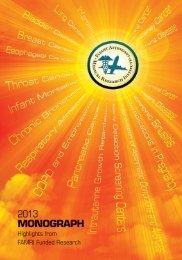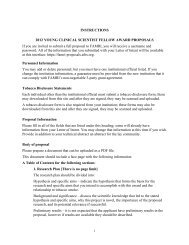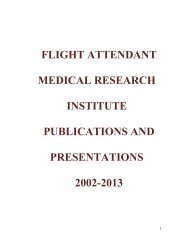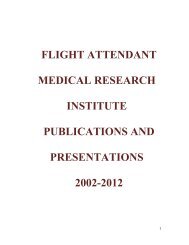MISSION
2009 compendium of FAMRI-supported research - Flight Attendant ...
2009 compendium of FAMRI-supported research - Flight Attendant ...
You also want an ePaper? Increase the reach of your titles
YUMPU automatically turns print PDFs into web optimized ePapers that Google loves.
pression/reduction of MCP-1 and long-lasting changes in the balance between PEDF and VEGF. If confirmed,<br />
analysis of blood MCP-1, PEDF, VEGF, quinones, nicotine, and cotinine, as well as analysis of<br />
urine quinones and cotinine, will serve as biomarkers for risk of progression of AMD. Importantly, results<br />
from this study will be directly applicable to other cardiovascular diseases associated with SHS.<br />
A ROLE FOR CATHEPSIN B IN SECOND HAND TOBACCO SMOKE-RELATED VASCULAR DISEASES<br />
Eunok Im, PhD; University of California, Los Angeles; YCSA 2006<br />
SHS increases the risk of ocular diseases. For instance, the vascularized form of age-related macular<br />
degeneration (AMD), one of the malicious vascular diseases that lead to blindness in the elderly, is tightly<br />
associated with SHS. Therefore, identifying regulators of vessel formation will aid in finding early diagnostic<br />
tools and ways to prevent disease progression. Dr. Im discovered that cathepsin B (a lysosomal cysteine<br />
protease) inhibits angiogenesis by suppressing pro-angiogenic factors (vascular endothelial cell growth factor)<br />
and generating anti-angiogenic factors (endostatin). These findings reveal cathepsin B as modulator of<br />
angiogenesis. The goal of Dr. Im’s project is to fully elucidate the mechanism by which cathepsin B modulates<br />
pro- and anti-angiogenic factors, and apply this information to the development of effective approaches<br />
to control SHS-induced angiogenesis. First, it will determine if cathepsin B inhibits angiogenesis. By<br />
comparison of ocular angiogenesis in cathepsin B null mice and control mice expansion of the understandings<br />
of how cathepsin B affects AMD will occur. Second, assessment of the combination of SHS and loss<br />
of cathepsin B will be conducted. Tests will be performed to show if SHS promotes angiogenesis within<br />
the eye and if the combination of SHS and loss of cathepsin B intensifies angiogenesis. Finally, Dr. Im and<br />
colleagues will investigate how cathepsin B regulates the stability of hypoxia-inducible factor 1 subunit a<br />
(HIF-1a), and the outcome of these studies will substantially advance the understanding of how HIF-1a is<br />
controlled. The molecular dissection of angiogenesis will enable better treatment and control of diseases<br />
arising from SHS.<br />
FAMRI Supported Publications<br />
Rhee SH, Im E, Pothoulakis C. Toll-like receptor 5 engagement modulates tumor development and<br />
growth in a mouse xenograft model of human colon cancer. Gastroenterology 2008;135(2):518-528.<br />
VISION<br />
COMPLETED RESEARCH<br />
INFLAMMATION, SMOKING, AND BLINDNESS FROM OCULAR NEOVASCULARIZATION<br />
Scott W. Cousins, MD; Duke University; CIA 2004<br />
Neovascular acute macular degeneration (AMD), typified by choroidal neovascularization and invasion<br />
of abnormal new blood vessels into the retina, has pathogenic features similar to other cardiovascular diseases,<br />
particularly macrophage infiltration. AMD is caused by exposure to cigarette smoke. Dr. Cousins’<br />
research tested the hypothesis that tobacco smoke-related nicotine acts upon circulating monocytes to<br />
induce partially activated monocytes in the blood. The monocytes are recruited to the eye in areas of<br />
choroidal neovascularization and lead to increasingly severe neovascularization via tumor necrosis factor<br />
alpha (TNF-alpha) production (a potent cytotoxic and angiogenic factor). The relationships between neovascular<br />
AMD, blood cotinine levels, and partial activation of blood monocytes were evaluated in a human<br />
case-control study of passive and active smokers versus non-smokers. If a relationship were confirmed, it<br />
would allow blood monocyte activation status to serve as a biomarker for risk of AMD progression. The<br />
results of this study are also applicable to other cardiovascular diseases caused by exposure to cigarette<br />
smoke. A similar study in mice evaluated the capacity of passive and active cigarette smoke (or nicotine) to<br />
affect bone marrow progenitor cells, causing them to differentiate into activated monocytes after smoking<br />
cessation. Results demonstrated that mice exposed to cigarette smoke suffered more severe pathology in<br />
the bone marrow stem cells than those who were not exposed. Dr. Cousins’ results carry an implication of<br />
particular interest to FAMRI, i.e., that flight attendants and others exposed to SHS may have long-term<br />
changes in bone marrow stem cells predisposing them to vascular diseases, including atherosclerosis and<br />
macular degeneration, long after cessation of the cigarette smoke exposure.<br />
P A G E 2 1 5







